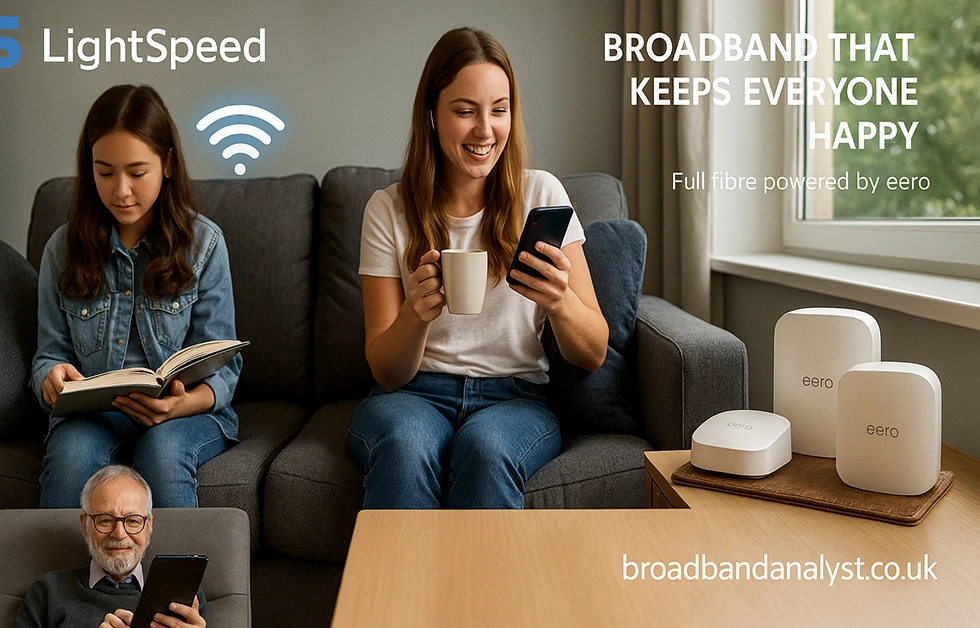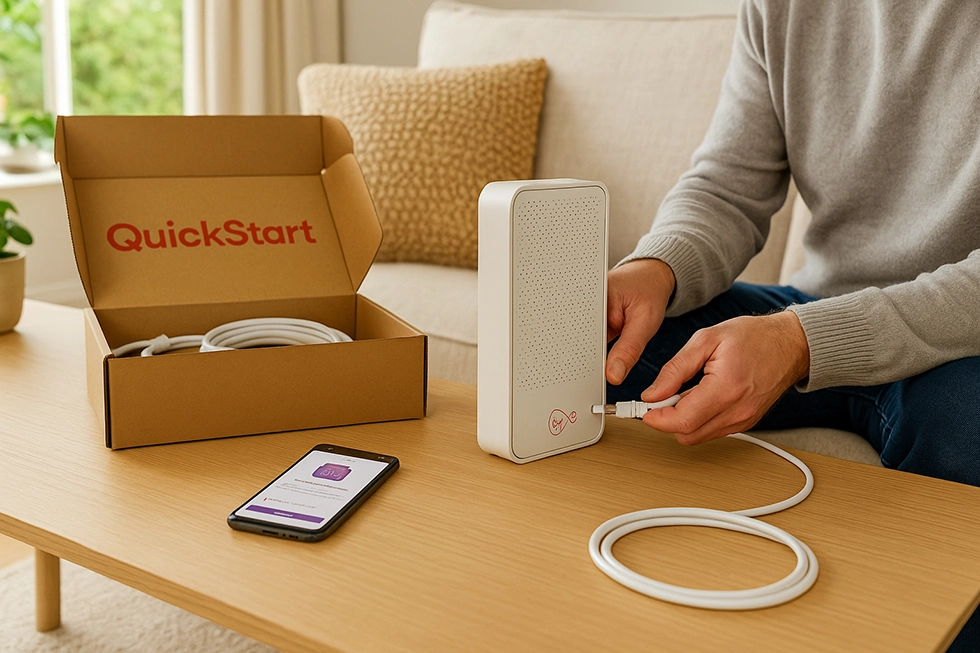LightSpeed Broadband Review 2025
LightSpeed Broadband is one of the newer full fibre providers making an impact across parts of the East of England and the West Midlands. While the ISP doesn’t have the national coverage of BT or Virgin Media, it has built a reputation for offering something most mainstream providers still don’t deliver: symmetrical upload and download speeds on every package.
Alongside this, LightSpeed equips customers with Amazon eero Wi-Fi 7 systems, ensuring that the home network experience matches the capability of the fibre connection itself.

In this review we’ll look closely at what LightSpeed offers, who it’s best suited for, how it compares with rivals, and where its network is available today. We’ll also consider customer feedback, hardware performance, and the practical details around pricing, switching, and installation.
Lightspeed Broadband Deals
LightSpeed sells a straightforward ladder of packages, all of them symmetrical:
Full Fibre 150
This entry-level plan offers 150Mbps download and 150Mbps upload. It is more than adequate for small households or couples who stream video in HD, make regular video calls, and want responsive browsing. The symmetric upload speed means that video calls are smooth and cloud backups complete quickly, avoiding the frustration of slow send speeds.
Full Fibre 500
At 500Mbps both ways, this package targets medium-sized households with several devices in use at the same time. Multiple 4K streams, online gaming, and larger downloads are easily supported. Remote workers who need to send large files or join HD video conferences will find this plan a comfortable fit.
Full Fibre 1Gb
The gigabit tier offers 1000Mbps download and 1000Mbps upload. This plan is best for larger households, home offices running demanding workflows, or those who want to ensure the connection never becomes a limiting factor. It is also the first tier to include the eero Pro 7 router by default, which provides stronger Wi-Fi coverage and support for multi-gigabit local connections.
Full Fibre 2Gb
The flagship package delivers 2000Mbps both ways. It is designed for enthusiasts, content creators with large media libraries, and households running many devices concurrently. To take advantage of 2Gb speeds, users need modern equipment such as 2.5GbE or 5GbE wired network cards and Wi-Fi 7-capable devices. While not every home will need this much capacity, it provides future-proofing for those who want the best possible performance today.
£4.99 setup fee applies.
Pricing and contract length
Pricing for LightSpeed packages varies with promotions but generally sits competitively alongside larger providers. The entry-level plans can sometimes be found for under £20 per month, while the 500Mbps and 1Gb tiers are priced higher but remain good value considering the symmetrical upload speeds.
Contracts are usually 24 months, although occasional shorter contracts have been offered. A notable difference compared to the major providers is that LightSpeed positions itself with no mid-contract price rises. Where BT, EE, and Vodafone typically apply an annual increase, LightSpeed commits to keeping prices flat during the minimum term. This is a significant advantage for customers who want certainty about what they will pay.
Activation fees vary: sometimes setup is reduced or waived during promotions, while in other cases an upfront charge applies. It is important to check the order basket carefully for the live figure at the time of signing up.
Another selling point is the switching credit. LightSpeed will contribute up to £350 towards early termination fees when you move from another ISP, provided you submit the final bill and meet the claim conditions. This can reduce the barrier for customers still in contract elsewhere.
Who is LightSpeed suited for?
LightSpeed’s packages are designed to meet the needs of households that want symmetrical download and upload speeds. This makes them particularly suitable for remote workers, content creators, and families with many connected devices. Because upload speeds are the same as download speeds, customers can back up files to the cloud, upload videos, or make high-quality video calls without hitting the bottlenecks that often affect packages from BT, Sky or Virgin Media.
At the higher end of the scale, the 1Gb and 2Gb plans give households the headroom to run multiple 4K streams, gaming sessions, and demanding work tasks simultaneously. Homes with many smart devices or users all working online at the same time are unlikely to run into congestion.
If you only need basic internet or you’re looking for a package that includes TV and extras, LightSpeed might not be the right fit. It sticks to broadband only, so for full bundles, it’s worth checking what the bigger providers offer.
Hardware and Wi-Fi experience
LightSpeed supplies Amazon eero Wi-Fi 7 routers. These are the latest generation of mesh routers designed to provide strong wireless signals across a home. The standard eero 7 is supplied with the 150Mbps and 500Mbps packages, while the eero Pro 7 comes with the 1Gb and 2Gb plans. Customers on lower tiers can pay to upgrade if they wish.
The eero systems are controlled through a smartphone app, which handles setup, optimisation, and the addition of extra nodes if mesh coverage is needed. Features such as parental controls and guest networks are included.
Earlier LightSpeed installs used a Nokia hub, and support documents still reference this hardware in places. Customers moving from a Nokia setup to eero may see both mentioned in guidance, particularly if they use their own third-party router in bridge mode.
Providing Wi-Fi 7 hardware as standard sets LightSpeed apart from many rivals, where older Wi-Fi 5 or Wi-Fi 6 routers are still common. This ensures that the home network is ready to handle multi-gigabit connections and that wireless speeds are less of a bottleneck.
Installation and setup
The installation process follows the usual FTTP model. An engineer will bring a fibre cable into the home and fit an Optical Network Terminal (ONT). The eero router is then connected to the ONT, and the Wi-Fi network is configured on site.
Customers can test speeds over a wired connection first to confirm that the service is delivering as expected. Wireless speeds will vary depending on device capability and placement of the eero units. Additional eero devices can be plugged in later to extend coverage, with adoption handled via the mobile app.
For customers switching from the older Nokia hub, migration notes are provided. If a third-party router or special configuration was used before, it may need adjusting when moving to the new hardware.
Customer service and support
LightSpeed offers support by phone and email, and provides an online portal with technical articles and FAQs. The portal covers topics such as router compatibility, setup guides, and troubleshooting steps.
Reviews suggest that many customers have positive experiences with LightSpeed’s support team, praising the responsiveness and helpfulness of staff. On Trustpilot, the provider maintains a strong overall rating. However, there are also reports of frustrations in areas where the installation was delayed, with some customers experiencing long waits for installation or having orders cancelled.
As with many altnets, communication around rollout and activation dates is an area that could improve. Still, once connected, most feedback suggests the service itself is stable and performs as advertised.
Availability and coverage
LightSpeed is a regional provider rather than a nationwide one. Its network is concentrated in towns across Lincolnshire, Norfolk, Suffolk, Rutland, Essex, Cambridgeshire, and parts of Staffordshire. Rollouts are done in clusters, with service going live town by town.
Some of the more prominent areas where LightSpeed is already available include Spalding, Sleaford, Skegness, Oakham, Newcastle-under-Lyme and Kidsgrove. In early 2025, Cromer and Sheringham were also added to the footprint. The provider has stated targets of reaching more than 50 towns and around 350,000 premises by the end of 2025.
Switching in and out
LightSpeed participates in the UK’s One Touch Switching framework, designed to make moving between broadband providers easier. For customers joining LightSpeed, the contract buy-out contribution of up to £350 helps offset any early exit fees. To claim, customers must submit their final paid bill within the specified time window.
For customers leaving LightSpeed, the usual cooling-off and notice periods apply. Contracts generally run 24 months, so leaving early may incur fees unless covered by the minimum speed guarantee or a switching scheme. As always, it is wise to keep records of bills and correspondence in case they are needed later.
How LightSpeed compares with bigger providers
When comparing LightSpeed with national providers, the key differentiator is symmetric upload speeds. Most Openreach-based ISPs offer much lower upload speeds than download, even on fast fibre packages. Virgin Media’s cable network has also traditionally lagged on uploads, though upgrades are ongoing. For households that value uploads, LightSpeed stands out clearly.
Hardware is another area of difference. LightSpeed supplies Wi-Fi 7 routers as standard, while many competitors still ship Wi-Fi 6 or even Wi-Fi 5 devices. This helps ensure that the speed of the fibre connection is usable across the home.
On the other hand, larger providers can offer national availability, bundled TV, and mobile deals. Customers who want a single provider for broadband, phone, and TV may find LightSpeed less appealing. Customer service metrics are also harder to compare, since Ofcom does not yet publish separate figures for small altnets.
Pricing is competitive, especially when switching credits are factored in. LightSpeed’s no mid-contract increase promise is also a differentiator, offering price stability that BT, EE, and Vodafone do not match.
Is LightSpeed any good?
For households within its network areas, LightSpeed is a compelling choice. Every plan offers symmetrical speeds, Wi-Fi 7 hardware, and no in-contract price rises. The packages are straightforward, and the switching credit reduces the cost of leaving another ISP.
The main limitation is availability. LightSpeed is not yet widespread, and even within live towns not every address is serviceable. Installation delays have been reported in some areas, so customers should check carefully and be prepared for potential wait times.
For those who can get it, however, the combination of symmetric speeds, modern routers, and competitive pricing makes LightSpeed easy to recommend. It is particularly attractive for remote workers, content creators, and larger households who value strong upload performance and whole-home Wi-Fi.
As the rollout continues and wholesale partnerships strengthen the network, LightSpeed looks set to remain one of the more innovative and user-focused fibre providers in the regions it serves.
